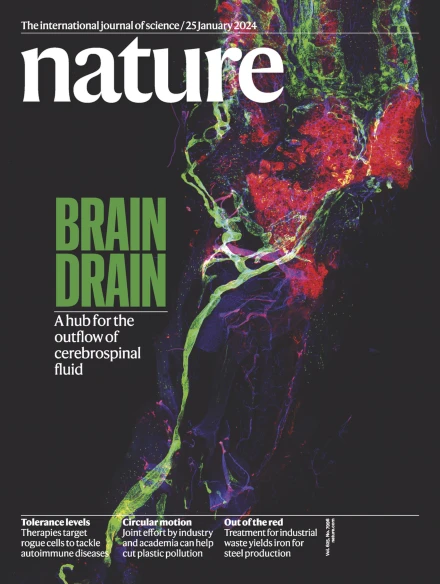Singular dielectric nanolaser with atomic-scale field localization
IF 48.5
1区 综合性期刊
Q1 MULTIDISCIPLINARY SCIENCES
引用次数: 0
Abstract
Compressing the optical field to the atomic scale opens up possibilities for directly observing individual molecules, offering innovative imaging and research tools for both physical and life sciences. However, the diffraction limit imposes a fundamental constraint on how much the optical field can be compressed, based on the achievable photon momentum1,2. In contrast to dielectric structures, plasmonics offer superior field confinement by coupling the light field with the oscillations of free electrons in metals3–6. Nevertheless, plasmonics suffer from inherent ohmic loss, leading to heat generation, increased power consumption and limitations on the coherence time of plasmonic devices7,8. Here we propose and demonstrate singular dielectric nanolasers showing a mode volume that breaks the optical diffraction limit. Derived from Maxwell’s equations, we discover that the electric-field singularity sustained in a dielectric bowtie nanoantenna originates from divergence of momentum. The singular dielectric nanolaser is constructed by integrating a dielectric bowtie nanoantenna into the centre of a twisted lattice nanocavity. The synergistic integration surpasses the diffraction limit, enabling the singular dielectric nanolaser to achieve an ultrasmall mode volume of about 0.0005 λ3 (λ, free-space wavelength), along with an exceptionally small feature size at the 1-nanometre scale. To fabricate the required dielectric bowtie nanoantenna with a single-nanometre gap, we develop a two-step process involving etching and atomic deposition. Our research showcases the ability to achieve atomic-scale field localization in laser devices, paving the way for ultra-precise measurements, super-resolution imaging, ultra-efficient computing and communication, and the exploration of light–matter interactions within the realm of extreme optical field localization. Singularity enables breaking the optical diffraction limit in a dielectric nanolaser.


具有原子尺度场定位的奇异介电纳米激光器。
将光场压缩到原子尺度为直接观测单个分子提供了可能,为物理和生命科学提供了创新的成像和研究工具。然而,基于可实现的光子动量,衍射极限对光场的压缩程度产生了根本性的限制1,2。与电介质结构相比,等离子体通过将光场与金属中自由电子的振荡耦合在一起,可提供更优越的场约束3-6。然而,等离子体存在固有的欧姆损耗,会导致发热、功耗增加,并限制等离子体器件的相干时间7,8。在此,我们提出并展示了奇异介质纳米激光器,其模式体积打破了光学衍射极限。根据麦克斯韦方程,我们发现电介质弓形纳米天线中持续存在的电场奇点源于动量发散。奇异电介质纳米激光器是通过将电介质领结纳米天线集成到扭曲晶格纳米腔中心而构建的。这种协同集成超越了衍射极限,使奇异介电纳米激光器实现了约 0.0005 λ3 (λ,自由空间波长)的超小型模式体积,以及 1 纳米尺度的超小特征尺寸。为了制造所需的具有单纳米间隙的介电领结纳米天线,我们开发了一种包括蚀刻和原子沉积的两步工艺。我们的研究展示了在激光设备中实现原子尺度场定位的能力,为超精确测量、超分辨率成像、超高效计算和通信以及在极端光场定位领域探索光与物质的相互作用铺平了道路。
本文章由计算机程序翻译,如有差异,请以英文原文为准。
求助全文
约1分钟内获得全文
求助全文
来源期刊

Nature
综合性期刊-综合性期刊
CiteScore
90.00
自引率
1.20%
发文量
3652
审稿时长
3 months
期刊介绍:
Nature is a prestigious international journal that publishes peer-reviewed research in various scientific and technological fields. The selection of articles is based on criteria such as originality, importance, interdisciplinary relevance, timeliness, accessibility, elegance, and surprising conclusions. In addition to showcasing significant scientific advances, Nature delivers rapid, authoritative, insightful news, and interpretation of current and upcoming trends impacting science, scientists, and the broader public. The journal serves a dual purpose: firstly, to promptly share noteworthy scientific advances and foster discussions among scientists, and secondly, to ensure the swift dissemination of scientific results globally, emphasizing their significance for knowledge, culture, and daily life.
 求助内容:
求助内容: 应助结果提醒方式:
应助结果提醒方式:


